
NASA-7 Biographies
| Thomas | Solovyev | Vinogradov | Musabayev | Budarin | Eyharts |
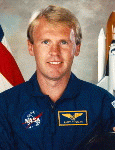 Andy
Thomas Biography
Andy
Thomas Biography
NAME: Andrew S. W. Thomas (Ph.D.) NASA Astronaut
PERSONAL DATA: Born December 18, 1951, in Adelaide, South Australia. Single. He enjoys horse riding and jumping, mountain biking, running, wind surfing, and classical guitar playing. His father, Adrian C. Thomas, resides in Hackham, South Australia. His mother, Mary E. Thomas, resides in North Adelaide, South Australia.
EDUCATION: Received a bachelor of engineering degree in mechanical engineering, with First Class Honors, from the University of Adelaide, South Australia, in 1973, and a doctorate in mechanical engineering from the University of Adelaide, South Australia, in 1978.
ORGANIZATIONS: Member of the American Institute of Aeronautics and Astronautics.
EXPERIENCE: Dr. Thomas began his professional career as a research scientist with the Lockheed Aeronautical Systems Company, Marietta, Georgia, in 1977. At that time he was responsible for experimental investigations into the control of fluid dynamic instabilities and aircraft drag. In 1980, he was appointed Principal Aerodynamic Scientist to the company and headed a research team examining various problems in advanced aerodynamics and aircraft flight test.
This was followed in 1983 by an appointment as the head of the Advanced Flight Sciences Department to lead a research department of engineers and scientists engaged in experimental and computational studies in fluid dynamics, aerodynamics and aeroacoustics. He was also manager of the research laboratory, the wind tunnels, and the test facilities used in these studies.
In 1987, Dr. Thomas was named manager of Lockheed's Flight Sciences Division and directed the technical efforts in vehicle aerodynamics, flight controls and propulsion systems that supported the company's fleet of production aircraft. In 1989, he moved to Pasadena, California, to join the Jet Propulsion Laboratory (JPL) and, shortly after, was appointed leader of the JPL program for microgravity materials processing in space. This NASA-sponsored research included scientific investigations, conducted in the laboratory and in low gravity on NASA's KC-135 aircraft, as well as technology studies to support the development of the space flight hardware for future Shuttle missions.
NASA EXPERIENCE: Dr. Thomas was selected by NASA in March 1992 and reported to the Johnson Space Center in August 1992. In August 1993, following one year of training, he was appointed a member of the astronaut corp and was qualified for assignment as a mission specialist on Space Shuttle flight crews. While awaiting space flight assignment, Dr. Thomas supported Shuttle launch and landing operations as an Astronaut Support Person (ASP) at the Kennedy Space Center. He also provided technical support to the Space Shuttle Main Engine project, the Solid Rocket Motor project and the External Tank project at the Marshall Space Flight Center.
In June 1995, Dr. Thomas was named as payload commander for STS-77 and flew his first flight in space on Endeavour in May 1996. He next trained at the Gagarin Cosmonaut Training Center in Star City, Russia in preparation for a long-duration flight. In 1998, he served as Board Engineer 2 aboard the Russian Space Station Mir for 130 days. He is in training for the STS-102 mission, targeted for launch in 2000.
STS-77 was a 10-day mission during which the crew deployed two satellites, tested a large inflatable space structure on orbit and conducted a variety of scientific experiments in a Spacehab laboratory module carried in Endeavour's payload bay. The flight was launched from the Kennedy Space Center on May 19, 1996 and completed 160 orbits 153 nautical miles above the Earth while traveling 4.1 million miles and logging 240 hours and 39 minutes in space.
On January 22, 1998, Dr. Thomas launched aboard Space Shuttle Endeavour as part of the STS-89 crew to dock with the Mir Space Station. He served aboard Mir as Flight Engineer 2 and returned to Earth with the crew of STS-91 aboard Space Shuttle Discovery on June 12, 1998, completing 141 days in space and 2,250 orbits of the Earth.
_______________________________________________________________
| Thomas | Solovyev | Vinogradov | Musabayev | Budarin | Eyharts |
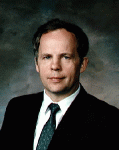 Anatoly
Solovyev Biography
Anatoly
Solovyev Biography
Anatoly Solovyev commanded two Mir flights during the Shuttle-Mir Program. The first was Mir 19, where he was in charge of the Russian crew that replaced Norm Thagard and his Mir-18 cosmonaut crewmates. Solovyev and Mir 19 Flight Engineer Nikolai Budarin launched to the Russian space station aboard a Space Shuttle on STS-71, marking the first time a Mir crew was ferried to the station on an American spacecraft. Additionally, Solovyev was the commander of the Mir-24 mission, which lasted from August 5, 1997, until February 19, 1998. He and Mir-24 Flight Engineer Pavel Vinogradov worked with two American astronauts on the space station, beginning with Michael Foale. Foale's mission began with the launch of the Space Shuttle Atlantis on May 15, 1997, and ended when he returned to Earth on October 6, 1997. He was replaced by David Wolf, whose mission started with the launch of the Space Shuttle Endeavour on September 25, 1997, and came to a close when he returned to Earth on January 31, 1998.
Solovyev graduated from Lenin Komsomol Chernigov Higher Military Aviation School in 1972 and was a Colonel and test pilot for the Soviet Air Force. He was selected as cosmonaut on December 1, 1978 and completed his general space training in 1979. He is a veteran of five spaceflights and has made a record 15 EVAs, spending a total of 74 hours and 41 minutes space walking. Solovyev also commanded Mir during David Wolf's stay, and Wolf indicated high praise for Solovyev in his Oral History: "I never dreamed [my first space walk] would be from a Russian spacecraft, in a Russian spacesuit, speaking Russian with a Russian who had been out sixteen times, the most experienced space walker in the world, and that's what Anatoly Solovyev is. So it was a real first-hand lesson from the number-one guy in the field, and that was a privilege."
_______________________________________________________________
| Thomas | Solovyev | Vinogradov | Musabayev | Budarin | Eyharts |
 Pavel
Vinogradov Biography
Pavel
Vinogradov Biography
Pavel Vinogradov was the flight engineer of the Mir-24 mission, which lasted from August 5, 1997, until February 19, 1998. He and Mir-24 Commander Vladimir Solovyev worked with two American astronauts on the space station, beginning with Michael Foale. Foale's mission began with the launch of the Space Shuttle Atlantis on May 15, 1997, and ended when he returned to Earth on October 6, 1997. He was replaced by David Wolf, whose mission started with the launch of the Space Shuttle Endeavour on September 25, 1997, and came to a close when he returned to Earth on January 31, 1998.
Vinogradov was born August 31, 1953 in Magadan, Magadan Oblast, Russia. He is married with three children.
Vinogradov graduated from Moscow Aviation Institute and was selected to become a cosmonaut on March 3, 1992.
_______________________________________________________________
| Thomas | Solovyev | Vinogradov | Musabayev | Budarin | Eyharts |
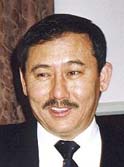 Talgat
Musabayev Biography
Talgat
Musabayev Biography
Talgat Musabayev was the flight engineer of the Mir-25 mission, which lasted from January 29, 1998, until August 25, 1998. He and Mir-25 Commander Nikolai Budarin worked with two American astronauts on the space station, beginning with David Wolf. Wolf's mission began with the launch of the Space Shuttle Endeavour on September 25, 1997, and ended when he returned to Earth on January 31, 1998. He was replaced by Andrew Thomas, whose mission started with the launch of the Space Shuttle Endeavour on January 22, 1998, and came to a close when he returned to Earth on June 12, 1998.
Musabayev was born January 7, 1951 in Kargaly, Dzhampul Oblast, Kazakhstan. He is married with two children.
He graduated from Red Banner Aviation School in Riga as an aviation engineer. Musabayev received several awards as an aerobatic flyer and was selected as a cosmonaut on May 11, 1990. In 1991, he was appointed to Major and transferred to the cosmonaut group of Air Force (TsPK-11).
_______________________________________________________________
| Thomas | Solovyev | Vinogradov | Musabayev | Budarin | Eyharts |
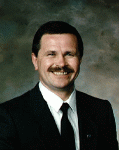 Nikolai
Budarin Biography
Nikolai
Budarin Biography
Nikolai Budarin was a crew member on two Mir flights during the Shuttle-Mir Program. The first was Mir 19, where he was the flight engineer on the Russian crew that replaced Norm Thagard and his Mir-18 cosmonaut crewmates. He and Mir 19 Commander Anatoly Solovyev launched to the Russian space station Mir aboard a Space Shuttle on STS-71, marking the first time a Mir crew was ferried to the station on an American spacecraft. Additionally, Budarin commanded the Mir-25 mission, which lasted from January 29, 1998, until August 25, 1998. He and Mir-25 Flight Engineer Talgat Musabayev worked with two American astronauts on the space station, beginning with David Wolf. Wolf's mission began with the launch of the Space Shuttle Endeavour on September 25, 1997, and ended when he returned to Earth on January 31, 1998. He was replaced by Andrew Thomas, whose mission started with the launch of the Space Shuttle Endeavour on January 22, 1998, and came to a close when he returned to Earth on June 12, 1998.
Budarin received a mechanical engineering diploma from the S. Ordzhonikidze Moscow Aviation Institute in 1979. He then joined NPO Energia where he was involved in experimental investigations and the testing of space technology. In 1989, Budarin enrolled as a candidate test cosmonaut, and he completed his training in 1991. The pilot of STS-71, Charles Precourt, recalled in his Oral History the initial language problems between the two: "So we had a forty-five-minute drive to Galveston, and he didn't speak much English and I didn't speak much Russian, but we were able to, with a dictionary, talk about a few things on the way down there. You think about how the relationships started there and where they've evolved to today, it's pretty incredible, because we couldn't even talk to each other back then and now we do everything together. It's neat. But, yes, when you think back on how it really first started, you would tend to believe those that said, 'You'll never be able to make this work.' So the fact that we did is pretty neat.
_______________________________________________________________
| Thomas | Solovyev | Vinogradov | Musabayev | Budarin | Eyharts |
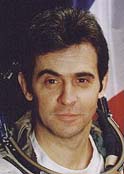 Leopold
Eyharts Biography
Leopold
Eyharts Biography
Personal Data: Born April 28, 1957, in Biarritz, France. He is married and has one child. His hobbies are jogging, mountain biking, tennis, reading and computers.
Education: Graduated as an engineer from the French Air Force Academy of Salon-de-Provence in 1979. He qualified as a fighter pilot in Tours in 1980 and graduated from the French test pilot school (EPNER) in Istres in 1988.
Special Honors: Léopold Eyharts has been decorated with the French Légion dHonneur, is Chevalier de l'Ordre National du Mérite. He has been awarded the Médaille d'Outre-Mer, the Silver Medal of the Défense Nationale and the Russian medals of Friendship and Courage.Service Medal.
Experience: He joined the French Air Force Academy of Salon-de-Provence and was graduated as an aeronautical engineer in 1979. In 1980 he became a fighter pilot and was assigned to an operational Jaguar A squadron in Istres Air Force Base (France). In 1985, he was assigned as a Flight commander in Saint-Dizier Air Force base.
In 1988, he was graduated as a test pilot in the French test pilot school (EPNER) and was assigned to the Brétigny-sur-Orge Flight Test Center near Paris, becoming Chief Test Pilot in 1990.
Eyharts has logged 3500 hours flying time on over 50 types of aircraft, 21 parachute jumps including one ejection. He holds a commission as Colonel in the French air force.
In 1990, Léopold Eyharts was selected as an astronaut by the French National Space Agency (CNES) and assigned to support the Hermes space plane program managed by the Hermes Crew Office in Toulouse. He became also one of the test pilots and engineer in charge of the CNES parabolic flight program (with Caravelle aircraft) and also carried out Airbus A300 Zero G qualification flights.
Léopold Eyharts underwent two short-duration training sessions at the Yuri Gagarin Cosmonaut Training Center near Moscow in 1991 and 1993 and took part in an evaluation of Russian "Bouran" Space Shuttle training in Moscow, where he flew in the Tupulev 154 Bouran in-flight simulator.
In 1992, he participated in the European Space Agency (ESA) astronaut selection .
In July 1994 he was assigned as a back-up crewmember for the Franco-Russian "Cassiopée" space flight, which took place in August 1996.
In December 1996 he was selected as cosmonaut for the CNES follow-on scientific space mission called "Pegase", which took place from 29 January to 19 February, 1998. In August 1998, Léopold Eyharts joined ESAs European Astronaut Corps whose homebase is the European Astronaut Center located in Cologne, Germany. He was assigned to train at NASAs Johnson Space Center in Houston, Texas and entered the 1998 Mission Specialist Class.
Spaceflight Experience: Mission to the Russian MIR Space Station (January 29 to February 19, 1998). During this Franco-Russian mission called "Pegase", he performed various French experiments in the area of medical research, neuroscience, biology, fluid physics and technology.